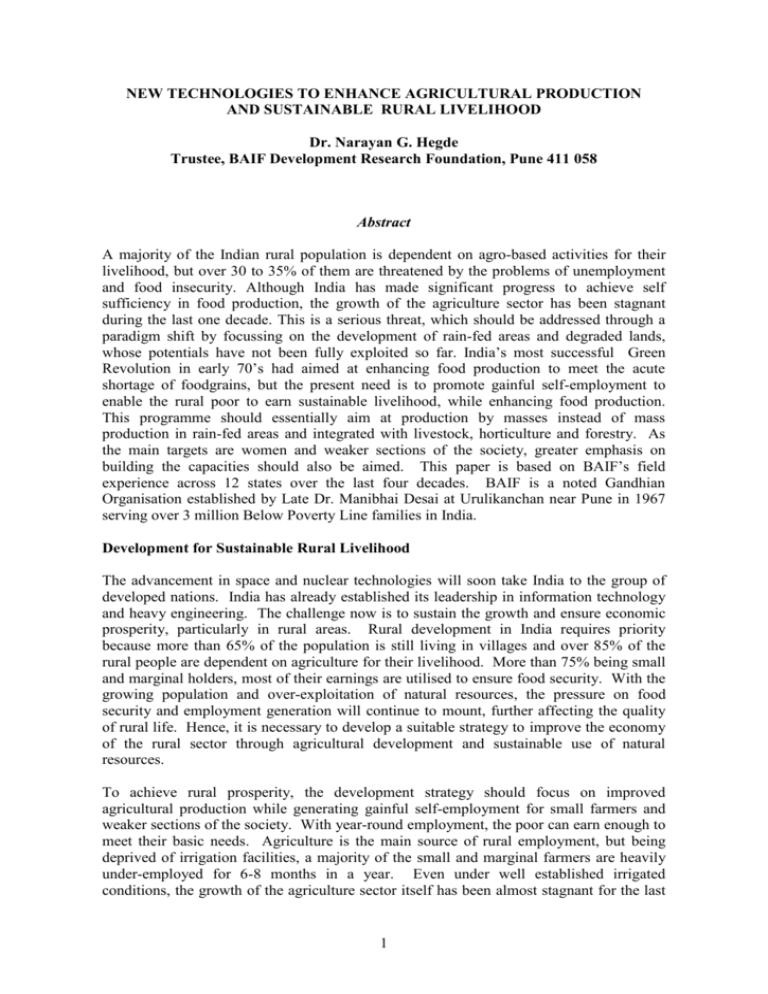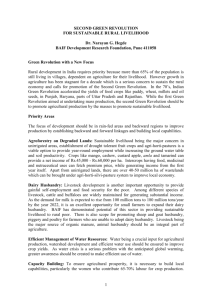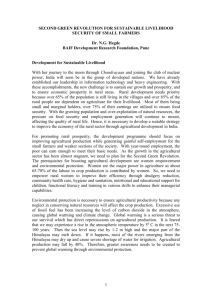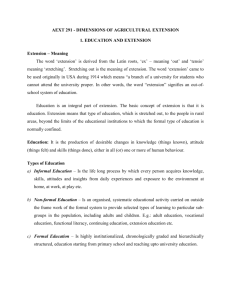second green revolution for sustainable
advertisement

NEW TECHNOLOGIES TO ENHANCE AGRICULTURAL PRODUCTION AND SUSTAINABLE RURAL LIVELIHOOD Dr. Narayan G. Hegde Trustee, BAIF Development Research Foundation, Pune 411 058 Abstract A majority of the Indian rural population is dependent on agro-based activities for their livelihood, but over 30 to 35% of them are threatened by the problems of unemployment and food insecurity. Although India has made significant progress to achieve self sufficiency in food production, the growth of the agriculture sector has been stagnant during the last one decade. This is a serious threat, which should be addressed through a paradigm shift by focussing on the development of rain-fed areas and degraded lands, whose potentials have not been fully exploited so far. India’s most successful Green Revolution in early 70’s had aimed at enhancing food production to meet the acute shortage of foodgrains, but the present need is to promote gainful self-employment to enable the rural poor to earn sustainable livelihood, while enhancing food production. This programme should essentially aim at production by masses instead of mass production in rain-fed areas and integrated with livestock, horticulture and forestry. As the main targets are women and weaker sections of the society, greater emphasis on building the capacities should also be aimed. This paper is based on BAIF’s field experience across 12 states over the last four decades. BAIF is a noted Gandhian Organisation established by Late Dr. Manibhai Desai at Urulikanchan near Pune in 1967 serving over 3 million Below Poverty Line families in India. Development for Sustainable Rural Livelihood The advancement in space and nuclear technologies will soon take India to the group of developed nations. India has already established its leadership in information technology and heavy engineering. The challenge now is to sustain the growth and ensure economic prosperity, particularly in rural areas. Rural development in India requires priority because more than 65% of the population is still living in villages and over 85% of the rural people are dependent on agriculture for their livelihood. More than 75% being small and marginal holders, most of their earnings are utilised to ensure food security. With the growing population and over-exploitation of natural resources, the pressure on food security and employment generation will continue to mount, further affecting the quality of rural life. Hence, it is necessary to develop a suitable strategy to improve the economy of the rural sector through agricultural development and sustainable use of natural resources. To achieve rural prosperity, the development strategy should focus on improved agricultural production while generating gainful self-employment for small farmers and weaker sections of the society. With year-round employment, the poor can earn enough to meet their basic needs. Agriculture is the main source of rural employment, but being deprived of irrigation facilities, a majority of the small and marginal farmers are heavily under-employed for 6-8 months in a year. Even under well established irrigated conditions, the growth of the agriculture sector itself has been almost stagnant for the last 1 8-10 years. Therefore, the policy makers and agriculture experts have been urging for the Second Green Revolution to accelerate growth in the agriculture sector. However, the task is more challenging as the potentials for enhancing crop yields have already been exhausted in the fertile agricultural belts covered under assured irrigation. Second Green Revolution with a new Focus In the 70’s, India was successful in creating a Green Revolution which gave a boost to the agriculture sector across the country. Green Revolution accelerated the yields of major food crops such as paddy, wheat, millets and oil seeds, particularly in the states of Punjab, Haryana, parts of Uttar Pradesh and Rajasthan. The success was due to introduction of high yielding varieties, development of effective agro-chemicals introduction of mechanisation and post production technologies for storage, processing and marketing. We need to create a similar revolution in the near future but with a focus on new areas where the benefits of the first Green Revolution could not be harnessed earlier, as we have already started experiencing stagnation in growth of agricultural production in the regions, which had contributed significantly to the success of the first Green Revolution. The first Green Revolution was launched to ensure food security as there was severe scarcity of food in the country. Today, our food supply is well secure. Meeting the growing needs is within reach. Therefore, the second Green Revolution should aim at promoting sustainable livelihood, enabling the poor to come out of poverty by generating gainful self-employment. While the first Green Revolution aimed at undertaking mass agricultural production, the second Green Revolution should be to promote agricultural production by the masses. This is the Gandhian approach to equitable sharing of prosperity by involving the poor in development. For achieving this goal, we need to search for technologies which can be adopted by the farmers in arid and semi-arid regions and those who are dependent on rainfall for crop production. Scope for Enhancing Agricultural Production While rich farmers in progressive areas will continue to make efforts to increase agricultural production through modern technologies and innovative inputs developed in the private sector, farmers in the rain-fed areas and backward regions will depend on the public sector research and development institutions to help them to improve agricultural productivity on degraded lands, with low investment in agricultural inputs. Hence, it is necessary to identify the target areas where there is good scope for improving agricultural production and technological problems encountered by those farmers. Agroforestry on Degraded Lands: Sustainable livelihood being the major concern, the development focus should be on generation of employment for small and marginal farmers, who are dependent on agricultural production on degraded lands in unirrigated areas. Presently, these lands are not being used intensively for high value crops. In fact, farmers often incur losses by farming on such lands, due to natural calamities. Such lands can be profitably used for establishment of drought tolerant fruit crops and agri-hortipastures. Tree crops have the ability to withstand the vagaries of nature without sustaining heavy losses. Tree-based farming can also provide year-round employment while protecting the soil from erosion and runoff of rain water. Promotion of tree-based farming will also enrich soil fertility and increase the water table while absorbing atmospheric carbon dioxide all round the year. 2 Farmers can easily earn a net income of Rs.45,000 - Rs.60,000 per ha from crops like mango, cashew, custard apple, amla and tamarind once the orchards start bearing fruits. Apart from foodgrains and vegetables, there are many under-utilised plant species having food, medicinal and nutraceutical uses which can be planted as inter-crops to fetch premium price even in local markets. Income from inter-crops can start from the first year itself to sustain livelihood of the participant families. Therefore, tree-based farming can improve the quality of life and protect the environment. Promotion of horticulture can further open up opportunities for post-harvest processing and marketing opportunities not only to add value to the produce but also to generate additional employment in rural areas. Apart from unirrigated lands, there are large stretches of wastelands in India. Among the estimated 40-50 million ha of wastelands, more than 9 million ha are sodic wastelands. Most of these lands were fertile irrigated fields which have turned sodic due to excessive use of water for irrigation and poor drainage facilities. As a result of such mismanagement of rich natural resources, the agricultural production has been seriously affected while causing unemployment for the land owners. With reclamation of sodic lands, it is possible to enhance food production by 50-75 million tons/annum, while creating employment for 8-10 million people. Similarly, several million hectares of ravine lands remaining idle for decades can be brought under agri-silvi-pasture system while improving the local economy and the biodiversity. For enhancing agricultural production on the above type of degraded and unproductive lands, it is necessary to introduce new technologies which can help in proper diagnosis of various problems and develop suitable solutions to address them. Following are some of the technologies useful while developing degraded lands and improving agricultural production in the country. Water Quality, Conservation and Utilisation: 1. 2. 3. 4. 5. Ground water survey, water current and storages Soil water content and techniques for easy measurement in the field Water requirements of crops to determine irrigation schedule Measuring salt and mineral contents in water and soils Technology for improving the quality of irrigation water Soil quality Improvement: 1. 2. 3. 4. Technology for chelating / precipitating harmful salts and minerals in soil Eco-friendly techniques for faster decomposition of stones and rocks Technology for cracking / breaking sub-surface hard / clay pans Improvement in soil texture enhance soil productivity and water holding capacity Nutrition Management: 1. Identification of microbes for accelerating bio-composting, facilitating efficient uptake, fixation and production of nutrients 2. Acceleration and production of plant growth hormones, growth promoters, flower inducers, fruit setters, fruit ripeners 3 Crop Protection: 1. 2. 3. 4. 5. 6. Genetic manipulation for improving crop yields and quality Bio-fungicide, bio-pesticides, disinfectants, Eco-friendly techniques for sterilisation, control of pests and diseases Techniques for drying and storage of seeds and food grains Foodgrain storage using techniques like low humidity, oxygen free chambers Techniques for long shelf life of fruits, vegetables and other food products Post- harvest Management: 1. 2. 3. 4. 5. Safe techniques (chemical free) of food preservation Low cost dehydration of fruits and vegetables Protection of natural colours and flavours in processed food Quick field tests to assess the pollutant levels in food products Technology for killing pathogens present in fresh and processed food Dairy Husbandry: Livestock development is another important opportunity to provide gainful self-employment and food security for the poor. A majority of the small farmers in India who do not have good quality land for agriculture, are dependent on livestock for supplementary income. Small farmers consider livestock as an important asset for earning their livelihood. Therefore, livestock is well distributed among the weaker sections of the community unlike land holdings. Among different species of livestock, cattle and buffaloes are widely maintained because of social acceptability and potential for generating substantial income. Promotion of dairy husbandry along with agri-hortipasture, traditionally known as mixed farming, can generate remunerative employment for small farmers throughout the year. India has the largest population of livestock in the world, but its production potential has not been optimally tapped so far. It is only during the last 2-3 decades that the dairy sector has made significant progress to increase milk production to meet the domestic demand of 100 million tons/year. However, the demand for milk is steeply rising and is expected to reach 180 million tons/year by the year 2022. The demand for meat is also expected to increase by 3-4 folds by this period. This can provide greater opportunity for small farmers to expand their dairy husbandry programme. It has been very well demonstrated by BAIF and many Dairy federations that there is scope for increasing milk production without increasing the livestock population. Probably, dairy husbandry is the only programme where poor families are able to build new assets every year in the form of crossbred cows, each worth over Rs. 25,000. There are also proven technologies to improve the supply of superior quality feeds and fodder, particularly to facilitate even the landless to take up dairy husbandry successfully. Promotion of forage shrubs and trees on degraded lands and backyards, treatment of agricultural by-products to improve the nutritional qualities and establishment of decentralised complete feed production units can be popularised by providing technical and infrastructural support. There is also a need to strengthen veterinary health care through an extensive network of vets and para-vets to ensure good health, which has a direct impact on the cost of milk production and the quality of milk. 4 There is also scope for promoting sheep and goat husbandry, piggery and poultry for farmers who are unable to adopt dairy husbandry. Livestock being the major source of organic manure, animal husbandry should be an integral part of agriculture. With the introduction of agricultural implements to improve the efficiency, preferably operated by a single animal, bullock power can become an ideal farm power for small farmers. Thus tree-based farming, particularly agri-horti-pastoral system linked with livestock development, can help in boosting the agricultural production while providing gainful selfemployment to small farmers. Following are the areas requiring new technologies to increase the productivity of the livestock industry: 1. Genetic improvement for enhancing production and quality 2. Sexing of semen and embryos 3. Diagnostic kit detecting heat, pregnancy and diseases 4. Induction of disease resistance 5. Development of low cost, thermo-resistant vaccines 6. New technologies for increasing hygiene and sanitation 7. Preventing afflotoxins in cattle food and methods for treating such feeds 8. Low cost animal health care using nuclear and light therapies 9. Improving the digestibility of inferior quality feed and fodder 10. Development of protein rich animal feeds through microbial digestion of wastes 11. Production of spirulina, single cell protein, Azolla, etc. for feeding livestock 12. Diagnosis of infertility problems and development of hormonal treatments 13. Techniques for clean milk production 14. Low cost cooling and processing of milk, meat and other food products 15. Value addition for milk, meat and other products 16. Efficient production of biogas from dung and animal wastes 17. Management and recycling of animal wastes and dead animals 18. Reduction in release of methane and carbon dioxide. Efficient Management of Water Resources: Water is a crucial input required to enhance agricultural production. As most of the small farmers are living in arid and semi arid regions and deprived of irrigation facilities, promotion of watershed development schemes and sustainable use of all the available water resources should be ensured to improve the crop yields. Fortunately, adequate financial support is available from various sources to accelerate this programme. In the absence of adequate water conservation measures, water scarcity is likely to be a serious bottleneck in the future. Water crisis can be a serious problem with the anticipated global warming and climate change. With increasing exploitation of natural resources and environmental pollution, the atmospheric temperature is expected to rise by 3-50C in the next 75-100 years. If it happens, most of the rivers originating from the Himalayas may dry up and cause severe shortage of water for irrigation, suppressing agricultural production by 40-50%. Rainfall is expected to be erratic and the water requirement for crops is likely to increase due to a significant increase in evaporation and transpiration losses. Therefore, greater awareness needs to be created to make efficient use of water resources and to prevent global warming through environmental protection as an integral part of Green Revolution. 5 There is scope for introducing new technologies in the following areas: 1. 2. 3. 4. 5. 6. Efficient harvesting and storage of rain water Reducing loss of water by evaporation in reservoirs and tanks Reducing ground water pollution Cost effective filtration of water for drinking Development of alternate and renewable sources of energy for rural uses Technologies for low water consumption by crops and trees Capacity Building: To ensure agricultural prosperity, involving rural masses particularly those at the bottom of the pyramid, it is necessary to build the capabilities of the participant families, particularly the women. Status of rural women has a direct influence on the agricultural production in India, as about 65-70% of the labour in crop production is contributed by women. Thus, women empowerment is the pre-requisite to boost agricultural production. Unless we undertake drudgery reduction, community health care, nutritional and educational programmes for children and training in various skills, women will not be able to contribute to agricultural improvement. As they are semi-literate and often lack confidence, it is necessary to provide various essential services at their doorsteps by posting well-trained para-extension workers selected within the community. They need mentors at the grassroot level, who can be approached any time, to seek solutions for their problems. Formation of Self Help Groups of farmers having common interests and user groups can be encouraged for awareness and motivation of the fellow farmers. Generally, the poor farmers who have been experiencing failures, are likely to develop a dependency syndrome. These families need regular support and peer group pressure to take active part in various development initiatives. Such support can be provided by the members of the user groups to one another. It is also easy and effective to communicate with the members through their group leaders. While there are solutions to address the anticipated technical problems, it is essential to rebuild the infrastructure to establish backward and forward linkages while launching various programmes. Presently, the organisations which deal with agricultural extension, input supply, credit and marketing at the village level are extremely weak. It is necessary to strengthen them. Many of these functions can be taken over easily by the People’s Organisations. In rural India, where the poor and illiterate people are lacking initiatives, any approach with a “supply push” is not likely to work. Thus, most of the Below Poverty Line families are not able to take advantage of various development schemes. We need to create a “demand pull” through awareness among the poor, about various opportunities and motivate them to take active part in socio-economic development. The local communities particularly, those belonging to the weaker sections of the society, who represent over 6570% of the rural population, should demand for the services to fulfil their needs, instead of the donors and traders imposing their ideas and products in rural areas. We need to build their capabilities and confidence to a level, when they will start demanding for various inputs and services. They need hand holding in the initial stage. Subsequently, the organisations of local people – self help groups and federations can take the responsibility of mentoring and facilitation. The people should own their programmes. 6 There are many unsolved problems affecting the quality of life of the people living in rural areas. Some of the important challenges which need to be addressed are presented below: 1. 2. 3. 4. 5. 6. Rapid diagnosis of the quality of drinking water Pumping of water from tube wells and open wells in the absence of power supply Water filters operated without power supply Easy techniques of maintain hygiene and sanitation Technology for preventing contamination of food from pathogens Techniques for promoting literacy among adult illiterates Concluding Remarks As rural poverty is a serious problem in India, we need to launch agricultural production through promotion of agri-horti-pastures on marginally productive and wastelands and livestock development, particularly dairy husbandry with a special focus on generation of gainful self-employment for the poor and weaker sections of the society. The programme should enhance agricultural production by involving a large number of small farmers and integrate with women empowerment, literacy and development of community organisations, for ensuring its success. Such a comprehensive programme can empower the rural poor to come out of poverty and enable the country to achieve the Millennium Development Goals, identified by the United Nations, for a sustainable future. The target areas being located in remote areas, they are deprived of basic amenities. Moreover, as the target population are poor and illiterate, there is a need to develop low cost economically viable technologies at the lower scale of operation. Such technologies can empower the poor to take active part in the process of strengthening the economy of the country. Dr. Narayan G. Hegde is a Trustee of BAIF. He has Post Graduate Degrees in Horticulture from the University of Pantnagar and University of Hawaii, Diploma in Agricultural Management from IIM Ahmedabad and Ph.D. in Economics from the University of Pune. During his 35 years of association with BAIF in various capacities, including as the President and Managing Trustee for 15 years, Dr. Hegde has been promoting conservation of natural resources, community forestry and sustainable agriculture with a strong emphasis on environmental protection for ensuring sustainable livelihood to rural poor. 7







